
   
Summer
/ Fall 2018
Volume
8, Issue 3
|
<< back
|
2018
Field Day at Wassamki Springs
Scarborough,
ME
by
Tim Watson, KB1HNZ
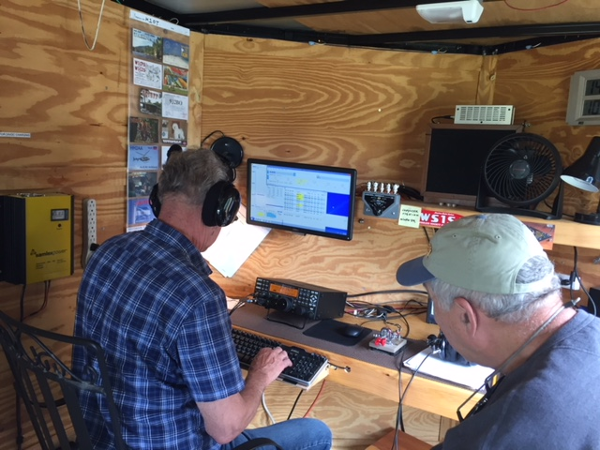 Rick K1OT makes the 1000th CW contact,
while Joe K1JB looks on
Rick K1OT makes the 1000th CW contact,
while Joe K1JB looks on
2018
Field Day was a tremendous success, and a lot of fun! Special thanks to
the Hillock family of Wassamki Springs Campground for hosting us for
the 8th consecutive year!
Operating twice around the clock, in
the 3A category, we captured 1,730 Bonus Points, and 6,968 QSO points,
which is a new record for WS1SM. The biggest areas of improvement this
year were in SSB QSOs (+500), and in the bonus points (+200) over last
year.
Setup began Friday morning, as Rick K1OT and helpers met
to raise his 40′ tower and antennas. Later in the evening Tim KB1HNZ
and Eric KC1HJK setup the Spiderbeam tribander.
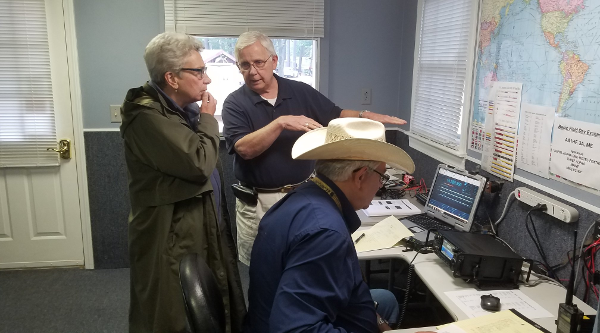 Scarborough Town Councilor, Jean-Marie
Caterina, spent time talking with participants and got a tour of the
GOTA station (above)
Scarborough Town Councilor, Jean-Marie
Caterina, spent time talking with participants and got a tour of the
GOTA station (above)
On-air
activities began at 2PM on Saturday, and continued through 2PM Sunday.
All the radios ran on 100% battery power, with the exception of a
handful of QSO that Charlie W1CPS made on solar power.
Frank
KR1ZAN and Steve AA1HF served as coaches for a Get on the Air (GOTA)
station, which operated concurrently in the Wassamki Springs Ham Shack,
which is located in the former camp store. There were 6 participants
who made QSOs!
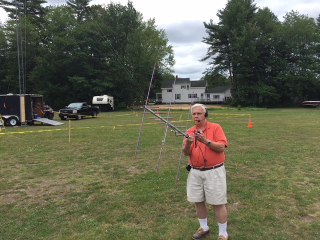 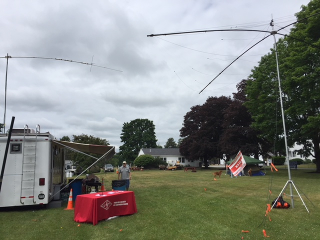 L: Frank KR1ZAN makes a satellite
contact. R: The WSSM Field Day setup
L: Frank KR1ZAN makes a satellite
contact. R: The WSSM Field Day setup
The
educational activity for this year was Radio Direction Finding, using
various methods, including a tape measure yagi, rotatable loop, and
attenuator.
Peter KC1HBM, invited Scarborough Town Councilor,
Jean-Marie Caterina, who spent some time talking to participants and
got a tour of the Field Day and GOTA operations.
Special thanks
to everyone who brought food to the pot luck supper on Saturday
evening, especially to Sheila Martin, W1DXX, who brought lots of pizza,
and Mike Mooney, who brought ribs and pulled pork!
Tim KB1HNZ
composed or replied to 23 messages, which were transmitted via Winlink
on HF. He also operated some digital modes over night on Saturday.
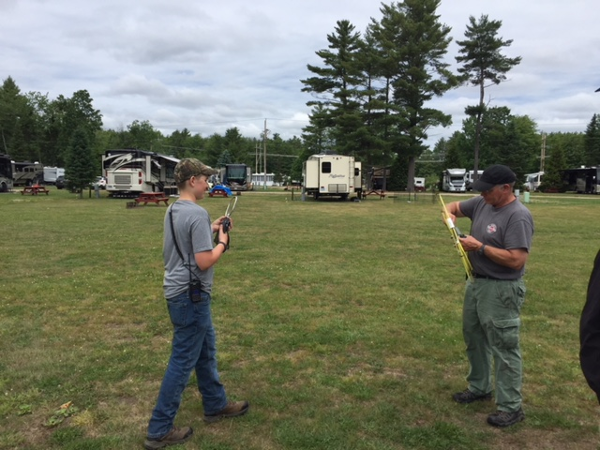 Above: Waylon KC1HJN and Steve AA1HF, use different methods to track down a hidden transmitter. Above: Waylon KC1HJN and Steve AA1HF, use different methods to track down a hidden transmitter.
The CW operators equaled last year’s total, and Charlie W1CPS came just 2 QSOs short of his previous best on 6 meters.
We also copied the Field Day bulletin, thanks to the efforts of Frank KR1ZAN and Ryan KB1YTR.
Frank, with the help of Waylon KC1HJN, also helped us get a satellite QSO during the last SO50 pass of the day.
Field Day was a massive team effort, and it wouldn’t have been possible without everyone’s help. Great job everyone!
ILLW from
Spring Point Ledge Light
South Portland,
ME
by
Tim Watson, KB1HNZ
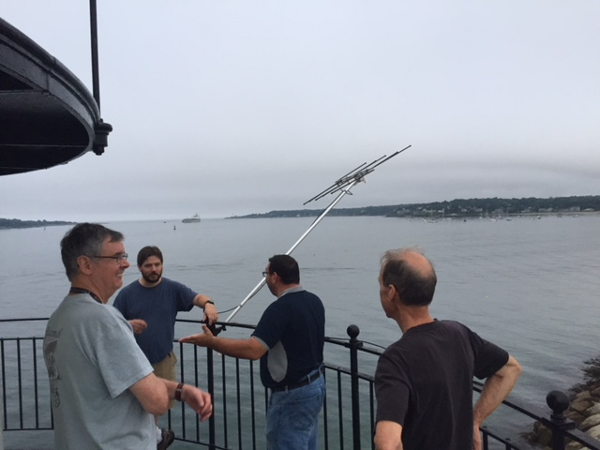
Above:
Keith AC1EG, Brad KC1JMH, Sean W1MSA, and Pete KC1DFO during setup on
Friday night
SOUTH PORTLAND, ME – During the weekend of August 18-19th, the WSSM
team activated Spring Point Ledge Lighthouse, in South Portland, ME,
for International Lighthouse & Lightship Weekend (ILLW). Club
members operated from 10am-4pm on both days, using the special event
call sign K1S.
2018 marked the 8th year that WSSM has participated in ILLW,
which sees over 500 light houses and lightships activated in over 40
countries. The international event helps promote the preservation of
lighthouses and lightships, and at the same time gives the community an
opportunity to experience Amateur Radio first hand.
Setup took place on Friday evening, with Sean W1MSA, Rory
KB1PLY, Pete KC1DFO, Keith AC1EG, Brad KC1JMH, and Tim KB1HNZ all
taking part. The team setup a BuddiPole rotatable dipole on the highest
platform of the lighthouse, and a station on the inside consisting of a
Yaesu FT857d, tuner, and battery power. They also setup an information
display.
By Saturday there was a second station setup, which consisted
of an Icom IC-7300 and a 40m dipole. Spring Point marked the first time
we were able to operate from inside an active lighthouse. Special
thanks to Keith Thompson AC1EG, and the Spring Point Ledge Light Trust
for their hospitality.
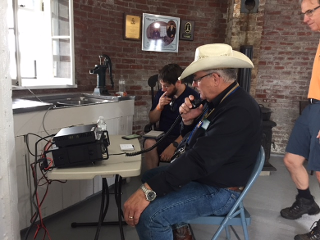
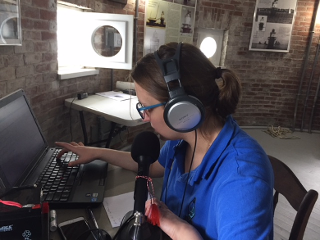 Above
left: Mike N5QYQ operates 40m while Brad KC1JMH logs, Above right:
Stefania K1GJY operates on 20m
Above
left: Mike N5QYQ operates 40m while Brad KC1JMH logs, Above right:
Stefania K1GJY operates on 20m
Particpants
included Mike Fandell N5QYQ, Charlie Shepard W1CPS, Sean Binette W1MSA,
Eric Emery KC1HJK, Curt Sachs K2IPH, Rory McEwen KB1PLY, Stefania
Watson K1GJY, Tim Watson KB1HNZ, Brad Brown, Jr. KC1JMH, Keith
Thompson AC1EG, and Peter Warren KC1DFO.
Click here to learn more about WSSM Lighthouse activations, and see more photos from the event.
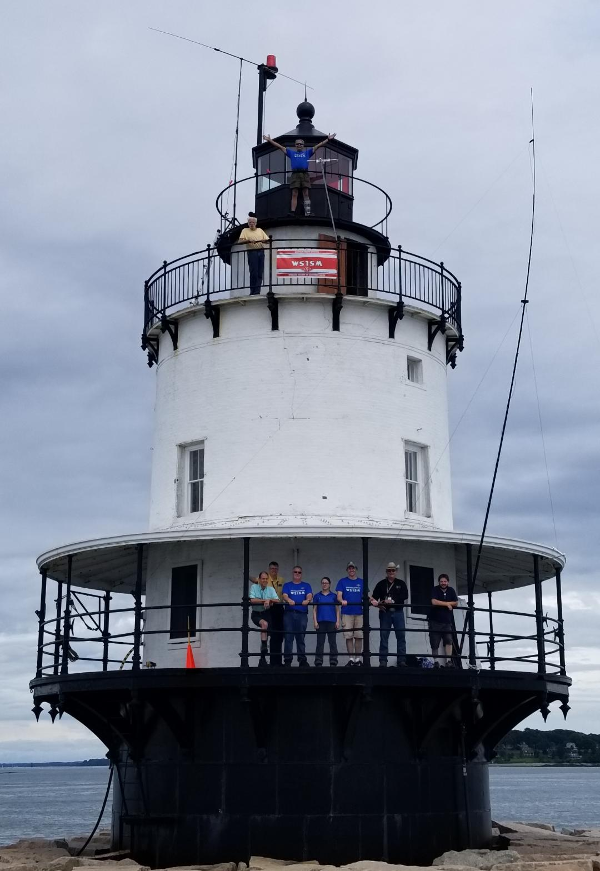 Above:
Our QSL card image, featuring Charlie W1CPS on the top platform, Curt
K2IPH, on the middle level, and L-R: Pete KC1DFO, Keith AC1EG, Rory
KB1PLY, Stefania K1GJY, Tim KB1HNZ, Mike N5QYQ, and Brad KC1JMH on the
lower level.
Above:
Our QSL card image, featuring Charlie W1CPS on the top platform, Curt
K2IPH, on the middle level, and L-R: Pete KC1DFO, Keith AC1EG, Rory
KB1PLY, Stefania K1GJY, Tim KB1HNZ, Mike N5QYQ, and Brad KC1JMH on the
lower level.
WSSM Participates in Regional Sheltering
Exercise
Windham, ME
by
Tim Watson, KB1HNZ
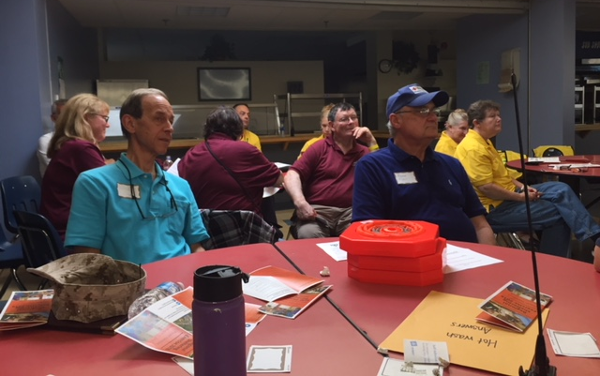 Above: Pete KC1DFO and Roger N1XP during
the morning briefing
Above: Pete KC1DFO and Roger N1XP during
the morning briefing
WESTBROOK,
ME – On Saturday, August 11th, WSSM Emergency Communications Team
members participated in a Regional Sheltering Exercise, at Westbrook
High School. The exercise was designed to improve the coordination and
integration of organizations and special teams in support of regional
sheltering operations during a disaster. Among those participating,
were the American Red Cross, Medical Reserve Corps, Cumberland County
Animal Response Team, Cumberland County Emergency Management Agency,
and the Westbrook School Department.
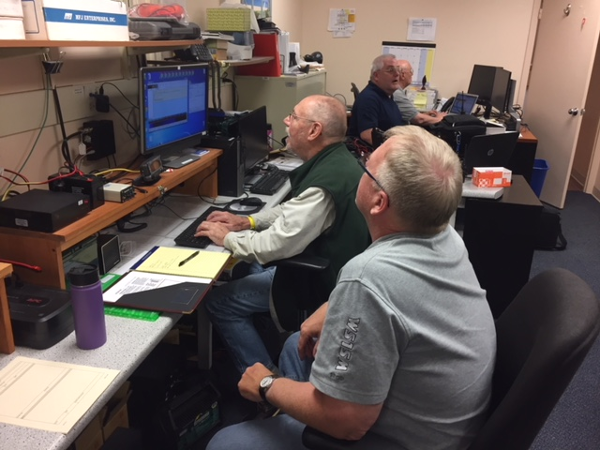 Above: CJ W1CJC, and Rory KB1PLY
operating the VHF station
Above: CJ W1CJC, and Rory KB1PLY
operating the VHF station
The
event began with a registration period in the morning, followed by
introductions, briefing, and a tour of the facility, and then exercise
play took place. It was followed up in the afternoon by a “Hotwash”
session, in which observations and comments from all the participants
were welcomed.
The WSSM-ECT team split into two groups, with one
staying at the shelter, and another heading to the Cumberland County
EMA bunker, in Windham. During the exercise, the shelter team was
provided with requisitions for supplies, for both the Red Cross and
CCART, to be forwarded to the Emergency Operations Center (EOC). These
messages were transcribed into a digital format and transmitted to the
bunker, where the staff at the EOC made assessments and sent back
replies.
From a technical standpoint, the operation was a
success, because the traffic was successfully sent and responded to,
but the team did identify a few areas to improve upon. One was that the
original message could be saved to a memory stick, which could be
passed from the originating party to the radio operator. This would
speed up the process considerably, and guarantee accuracy. Another was
that, since a number of participants were relatively new hams, some
additional training, especially with regards to the digital modes
software, was recommended.
During the exercise, on the shelter
side, Roger N1XP’s mobile setup was used. Special thanks to Roger for
getting things setup and organized! Other participants included Peter
Warren KC1DFO, Anne McBride, Brad Brown KC1JMH, Rory McEwen KB1PLY,
C.J. Carlsson W1CJC, and Tim Watson KB1HNZ.
DMR
Station QRM's AO-92 Uplink
AMSAT News Service
by Drew Glasbrenner, KO4MA
Recently
there has been a DMR signal QRM'ing the AO-92 uplink on 435.350 or
close by. Hotspots, repeaters, terrestrial simplex (anything not
satellite) should not be in 145.8-146.0 or 435-438 by international
bandplan. Please QSY these radios ASAP. Please share to DMR, D-star,
Fusion, P25 groups and similar, thank you!"
For amateur
operators in the U.S., FCC Part 97 has a bit to say about the way we
should operate in the 145.8-146.0 and 435-438 MHz amateur satellite
subbands. Regulations in many other countries are not as detailed as
those established by the FCC on how we should operate on different
frequencies and bands. This includes where
hotspots and similar
systems used for digital voice modes (i.e., DMR, D-Star, C4FM/Fusion)
and other technologies like EchoLink and IRLP, should operate.
Auxiliary stations are defined at 97.3(a)(7):
"An
amateur station, other than in a message forwarding system, that is
transmitting communications point-to-point within a system of
cooperating amateur stations."
This definition includes "remote
bases;" the nodes for systems like EchoLink and IRLP; and hotspots used
for digital-voice modes like D-Star, DMR, and Fusion/C4FM (among
others); as well as stations using these hotspots and nodes. Auxiliary
stations are not allowed in the 145.8-146.0 and 435-438 MHz satellite
subbands per 97.201(b) - among other subbands in the 2m and 70cm
amateur bands.
Repeaters are defined at 97.3(a)(40) as:
"Repeater.
An amateur station that simultaneously retransmits the transmission of
another amateur station on a different channel orchannels."
Since
most hotspots are operating on a single frequency, they would not
qualify as a repeater. Even if the hotspot operates like a repeater as
defined above, repeaters are not permitted to use 145.5-146.0 MHz and
435-438 MHz per 97.205(b).
Beyond these two sections, Part 97
also has 97.101(a): "In all respects not specifically covered by FCC
Rules each amateur station must be operated in accordance with good
engineering and good amateur practice."
Whether the hotspot is
interfering with a satellite downlink in a particular area, or it is
interfering with the satellite uplink affecting a much larger area,
this would not be good amateur practice.
In addition to subbands where hotspots are not permitted, 97.101(b) is
also relevant:
"Each
station licensee and each control operator must cooperate in selecting
transmitting channels and in making the most effective use of the
amateur service frequencies. No frequency will be assigned for the
exclusive use of any station."
Frequencies used by satellites
are usually incapable of being changed, and have been registered with a
regulator like the FCC and the ITU. Hotspots are usually
frequency-agile, and the frequencies used by those systems can be
changed to avoid potential interference to satellites and other
stations.
And all of this is in addition to local bandplans, which may already
have provisions for hotspots or simplex nodes.
DX
News
September 1 - November
3
by
Tim Watson, KB1HNZ
The Summer DX season was very active,
including expeditions to
Vietnam (3W9NH), the Maldives
(8Q7DT), and Market Reef (OJ0Y), in June, Timor Leste (4W6VA) and
Svalbard (JW100PUT) in July, and most recently the Austral Islands
(TX5T).
In the months ahead, there are several DXpeditions
planned to coincide with the Oceania DX Contest, which takes place
during the first two weekends of October, and the CQWW DX Contest,
which takes place on October 27-28. Besides the announced DXpeditions
listed below, look for pericontest activity around the contest dates.
Upcoming DXpeditions
09/01
- 09/10
09/01 - 09/17
09/04 - 09/14
09/08 - 09/17
09/12 - 10/01
09/14 - 09/23
09/15 - 09/27
09/16 - 09/28
09/17 - 09/26
09/17 - 09/30
09/20 - 10/22
09/21 - 10/06
09/26 - 10/10
09/28 - 10/14
09/29 - 10/06
09/30 - 10/12
10/01 - 10/12
10/09 - 10/21
10/10 - 11/06
10/15 - 11/04
10/20 - 11/03
|
EX0PL
J68HZ
A5A
V26K
T32AH
8Q7EC
3W9JK
3DA0AO
7Q7ELA
8Q7IP
ZD9CW
TO6OK
9X0T
5W0GC
VK9XT
C21GJ
ZA5V
TT8KO
V47JA
YJ0GC
VP6D
|
Kyrgyzstan
St. Lucia
Bhutan
Antigua
East Kiribati
Maldives
Vietman
eSwatini
Malawi
Maldives
Trisdan da Cunha
Mayotte
Rwanda
Samoa
Christmas I
Nauru
Albania
Chad
St. Kitts & Nevis
Vanuatu
Ducie I
|
By
SP9ONC and others; fm MN92ci; HF; QSL okay via Buro, Direct, &
Clublog
By K9HZ; fm Soufriere (IOTA NA-108); 160-2m; CW, SSB, RTTY
By JH1AJY and others; 40-6m; CW, SSB, FT8; QSL okay via Clublog
By AA3B; HF; holiday style; QSL okay via Buro or Direct.
By DL2AH; fm Christmas Island (IOTA OC-024); 80-10m; SSB, FT8, RTTY
By OE3DEC; fm Biyadhoo I (IOTA AS-013); 20m; SSB; holiday style
By SP5APW; fm Cham I (IOTA AS-162) & Hoi An; 20-6m; SSB
By HA5AO; 80-10m; CW, RTTY, FT8, some SSB; holiday style
By IW5ELA; mainly CW; holiday style
By HA3JB; fm Huhumale I (IOTA AS-013); 80-10m; CW, SSB, FT8, RTTY
By G4EDG; 80-15m; mainly CW, RTTY, some SSB; QSL via LZ1JZ
By OK1BOA and others; fm (IOTA AF-027); 160-10m; CW, SSB, RTTY, FT8
By I1HJT and others; 160-10m; CW, SSB, RTTY, and (FT8 on 20m only)
By LZ1GC; fm Apia (IOTA OC-097); 160-6m; CW, SSB, RTTY
By A25DC and others; fm (IOTA OC-002); CW, SSB, Digital
By W7GJ; fm (IOTA OC-031); 6m; mainly EME, but some CW, SSB, and FT8
By S59A and others; 80-2m; CW, SSB, JT65, FT8, MSK144, JT65B (for EME)
By LA7GIA; fm N'Djamena; 160-10m; CW, some SSB, QSL Direct via LA7GIA
By W5JON; fm Calypso Bay, St. Kitts; 160-6m; SSB, FT8
By LZ1GC; fm Efate I (IOTA OC-035); 160-6m; CW, SSB, RTTY
By K3EL and others; fm (IOTA OC-182); 160-10m; CW, SSB,
Digital
|
QSL
Corner
Many of Radio
Prague's broadcasts during
the month of August have been dedicated to the 50th Anniversary
of the Prague Spring liberalization movement that took place in 1968,
after the election of reformist, Alexander Dubcek. The reforms granted
unprecedented rights to Czechoslovak people, and began a partial
decentralization of the economy, before it was crushed when the Soviet
Union and other Warsaw Pact troops invaded on August 21st.
Below you'll find
images of Radio Prague's 2018 series of QSL cards commemorating
historic radio broadcasting equipment.
If you received an interesting QSL lately that you'd like to show off,
please send a digital image to kb1hnz@yahoo.com, and we'll
highlight it in an
upcoming issue!
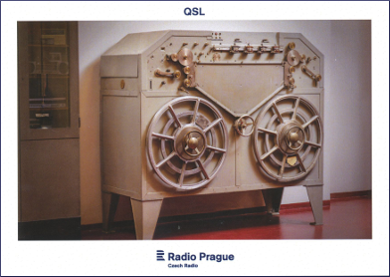
|
Radio Prague
for a report by Tim Watson,
KB1HNZ
07/05/18 0200 UTC
9955 kHz (WRMI)
QSL features: Blattnerphone -
recording machine
|
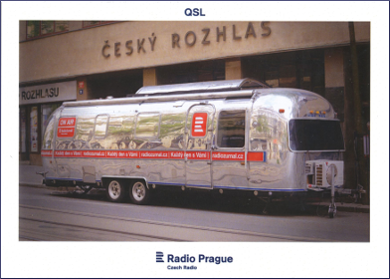
|
Radio Prague
for a report by Tim Watson,
KB1HNZ
07/17/18
0225 UTC
9955 kHz (WRMI)
QSL features: Airstream - promotional caravan
|
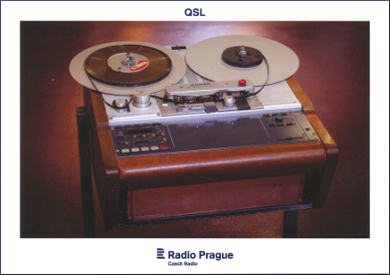
|
Radio
Prague
for a report by Tim Watson,
KB1HNZ
08/21/18
2200 UTC
via Podcast
QSL features: Studer reel to reel tape machine
|
|

If
you have any items for sale, contact one of our members to have it
listed here, or send an email to: w1wmg@yahoo.com
with a brief description and contact information.

Maine QSO Party - September
22-23
2018, Maine's Premier International HF Contest. For more
information, click here.
Windsor
Hamfest - September 22,
2018. Location: Windsor, ME. Type: ARRL
Hamfest. Sponsor: Augusta Amateur Radio Association. Click
here to learn more.
|
 Flea at
MIT
Flea at
MIT - September 16,
2018.
Location: Cambridge, MA. Type: Non-ARRL Hamfest. Sponsor: MIT Radio
Society. Click
here to learn more.
Flea at MIT - October 21,
2018.
Location: Cambridge, MA. Type: Non-ARRL Hamfest. Sponsor: MIT Radio
Society. Click
here to learn more.
FARA
Fest - November 3, 2018.
Location: Bourne, MA, Type: ARRL Hamfest. Sponsor: Falmouth Amateur
Radio Association. Click
here to learn more.
|

If you
have any items for trade, contact one of our members to have it listed
here, or send an email to: w1wmg@yahoo.com with a brief
description and contact information.

If
you offer any ham radio related services, for example, if you repair
meters or radios, build your own transmitters, make QSL cards to order,
or rebuild microphones, you may list these services here.

I f
there are any items you may be looking for, use this space to get the
word out. Just send an email to w1wmg@yahoo.com, or mention it at
an upcoming meeting. |
All
advertisements are listed for FREE. Advertising shall pertain to
products and services which are related to amateur radio. No
advertisement may use more than 40 words. Please send a description of
items for sale, wants, or services to Thom Watson at w1wmg@yahoo.com,
or bring it to an upcoming meeting of the Wireless Society of Southern
Maine. All ads will be printed one time, unless renewed.
|
Page
2
|























